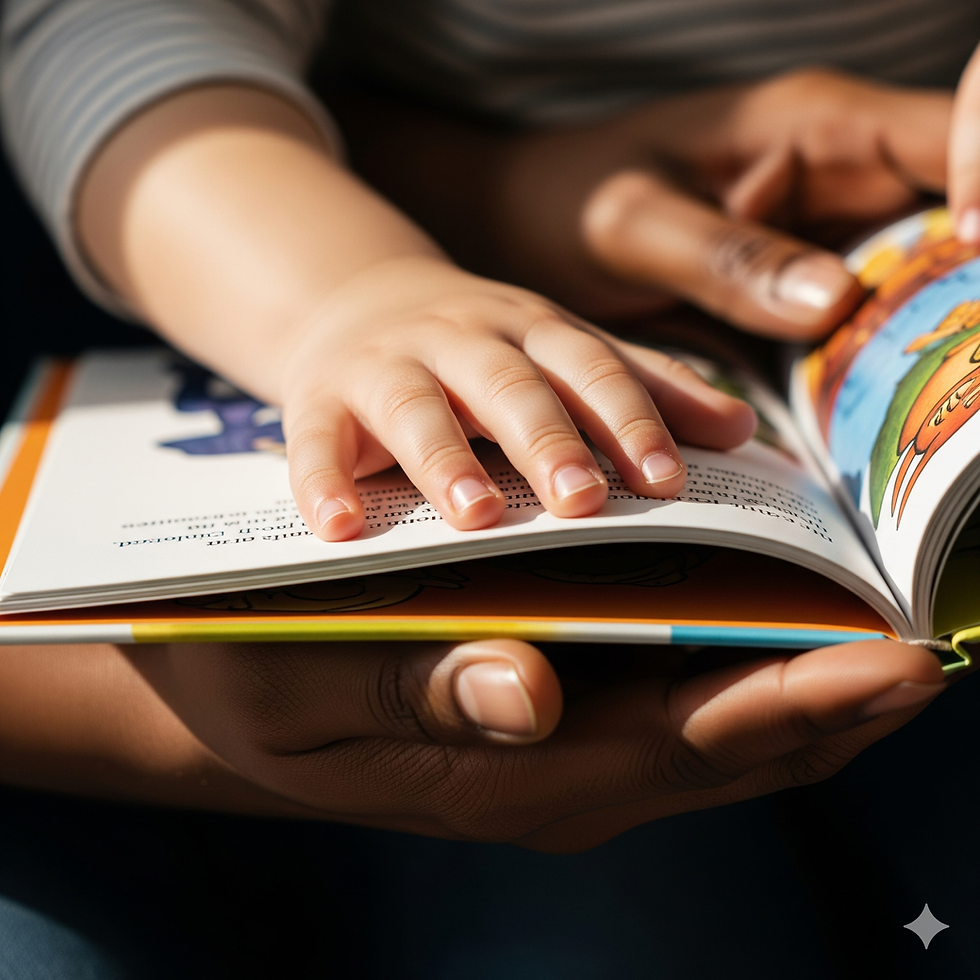Mindful Parenting RAD Series Part 3: Teaching Emotional Intelligence with Mindful SEL
- Sep 3
- 3 min read
Updated: Sep 30
Helping a Child with RAD Understand & Express Emotions
Children with Reactive Attachment Disorder (RAD) often struggle with emotional literacy. For many, feelings weren't safe during their early years. As a result, they may not know how to name or regulate their emotions. This is where mindful Social-Emotional Learning (SEL) comes in to help.
What’s SEL?
Social-Emotional Learning is a powerful tool that helps kids build essential skills, such as:
Self-awareness: Understanding their own emotions.
Self-regulation: Managing their feelings and reactions.
Empathy: Recognizing and understanding the emotions of others.
Relationship skills: Building healthy connections with peers and caregivers.
Mindfulness enhances SEL by promoting safety, presence, and reflection. It creates a nurturing environment where children can explore their emotions.
Start With Co-Regulation
Children with RAD often can't self-regulate yet. They need your calm presence to feel safe. You can say, “I’m here. You’re safe. Let’s breathe together.” This simple act of co-regulation can make a significant difference in their emotional journey.
6 Mindful SEL Practices
Here are six mindful SEL practices you can try with your child:
Feelings Check-In
Use emotion wheels or cards.
Ask, “What are you feeling today?” This encourages them to identify and express their emotions.
Breathing Buddy
Use a stuffed animal for belly breathing.
Encourage them to place the animal on their belly and watch it rise and fall as they breathe deeply.
Emotion Storytime
Pause during story time and ask, “What is this character feeling?” This helps them connect emotions to stories and characters.
Safe Place Visualization
Guide them in picturing a calm, cozy space.
Encourage them to describe what it looks like, feels like, and sounds like.
Feeling + Need Formula
Teach them to express their feelings using the formula: “I feel [emotion] because I need [need].”
This helps them articulate their emotions and needs more clearly.
Emotion-in-Body Mapping
Ask them where they feel different emotions in their body.
For example, “Where do you feel mad, sad, or happy?” This practice helps them connect emotions to physical sensations.
Real-Life Story: Feelings and Flashcards
Let me share a touching story about a foster parent who worked with a 6-year-old child struggling to name their feelings. Every emotion seemed to manifest as yelling, throwing things, or shutting down completely. To help, they introduced a simple feelings chart during breakfast each morning, asking, “Which one are you today?”
At first, the child consistently picked “mad,” and they would giggle about how “mad” kept showing up. However, after a challenging visit with their biological family one weekend, the child pointed to the “confused” face and quietly said, “This one’s in my belly.”
This moment marked a breakthrough. It was the first time the child used emotional language to describe their experience. Sparked by a calm, predictable SEL routine, this became the beginning of a new way for the child to feel seen and understood.
The Importance of Mindful SEL in Everyday Life
Incorporating mindful SEL practices into daily routines can profoundly impact a child's emotional growth. It creates a safe space for them to explore their feelings and learn to express themselves.
Building Emotional Vocabulary
By using tools like emotion wheels and feelings charts, we help children expand their emotional vocabulary. This is crucial for their development. The more words they have to describe their feelings, the better they can communicate their needs.
Creating Predictable Routines
Children with RAD thrive on predictability. Establishing a routine around SEL practices can provide them with a sense of security. Knowing what to expect helps them feel safe and more willing to engage.
Encouraging Connection
SEL practices also foster connection. When we take the time to check in on our children's feelings, we show them that their emotions matter. This builds trust and strengthens our relationship with them.
Gentle Encouragement for Caregivers
As caregivers, it’s important to remember that this journey is not always easy. You may feel overwhelmed at times, but you are not alone. Many families face similar challenges.
Here’s one approach you could try: Start small. Choose one SEL practice to incorporate into your daily routine. Gradually add more as you and your child become comfortable. Celebrate the small victories along the way. Each step forward is a step toward greater emotional understanding and connection.
Final Thoughts
Helping a child with RAD understand and express their emotions is a journey filled with ups and downs. But with patience, love, and the right tools, we can guide them toward a brighter emotional future.
Feel free to share your experiences or strategies that have worked for you. We’re all in this together, and your voice matters. Let’s continue to support one another on this important journey.
.png)


Comments